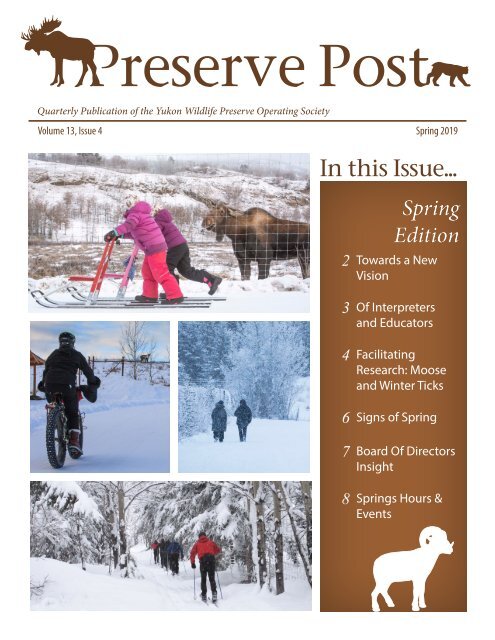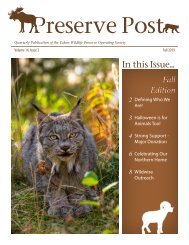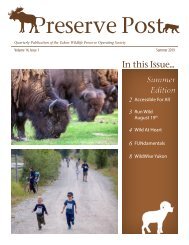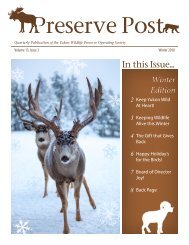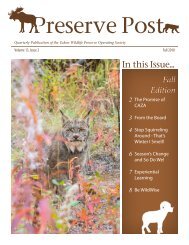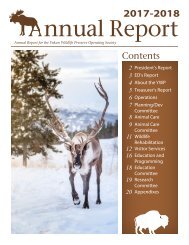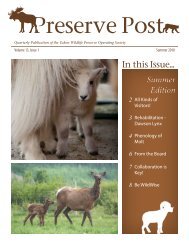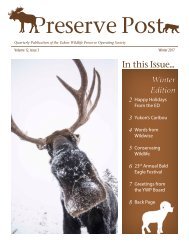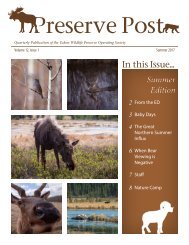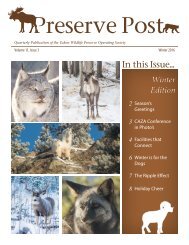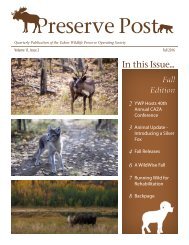2019 SPRING Newsletter
All the ways to explore the Preserve, self-powered wildlife viewing daily over March Break. Lots to look forward to this Spring and in the months ahead with ongoing research, new staff and board member highlights and big vision planning!
All the ways to explore the Preserve, self-powered wildlife viewing daily over March Break. Lots to look forward to this Spring and in the months ahead with ongoing research, new staff and board member highlights and big vision planning!
You also want an ePaper? Increase the reach of your titles
YUMPU automatically turns print PDFs into web optimized ePapers that Google loves.
Quarterly Publication of the Yukon Wildlife Preserve Operating Society<br />
Volume 13, Issue 4<br />
Spring <strong>2019</strong><br />
In this Issue...<br />
Spring<br />
Edition<br />
2 Towards a New<br />
Vision<br />
3 Of Interpreters<br />
and Educators<br />
4 Facilitating<br />
Research: Moose<br />
and Winter Ticks<br />
6 Signs of Spring<br />
7 Board Of Directors<br />
Insight<br />
8 Springs Hours &<br />
Events
Towards a New Vision<br />
I’m excited to share that the Preserve will undertake<br />
comprehensive masterplanning this year! Over the past<br />
three years we’ve worked hard to lay the groundwork<br />
and fund the project. With the support of CanNor and<br />
YG’s Community Development Fund, we’re finally<br />
ready to kick-off!<br />
The Yukon Wildlife Preserve opened its doors to<br />
the public in the spring of 2004. The newly formed<br />
YWP Operating Society developed a comprehensive<br />
masterplan, led by Peter Karsten. Karsten was<br />
president of the World Association of Zoos, Canada’s<br />
Accredited Zoos and Aquariums and CEO of the<br />
Calgary Zoo. With this broad perspective, he helped<br />
the YWP form a vision of the Preserve as a world-class<br />
wildlife experience.<br />
When I spoke to Karsten at our 10th Anniversary in<br />
2014 he talked about how special it was to be able to<br />
walk around and take “National Geographic cover<br />
photos”. He saw the incredible natural setting as<br />
2<br />
something that set us apart from typical zoological<br />
organizations, and made us unique. Under the<br />
guidance of this original plan, a lot has happened over<br />
the past 15 years.<br />
There’s a lot to live up to, but we’re excited to have<br />
an expert team to guide the development of a new<br />
masterplan. Leading the project are PJA Architects and<br />
Landscape Architects. They are zoo planning experts<br />
who’ve done work across North America (if you’ve<br />
been to the Canadian section of the Toronto Zoo, you<br />
know their work). A team of sub-consultants includes<br />
business planning and animal welfare experts. The<br />
Yukon context is unique, so we’re especially happy to<br />
have Stantec and Aasman Brand Communications on<br />
the team. We see this combination of international zoo<br />
expertise with local insights as the key to creating an<br />
exciting new vision!<br />
We want this plan to be something you’re just as<br />
excited about. To that end, we’ll keep you up to date as<br />
we move forward! We’d love to hear from you, so don’t<br />
hesitate to reach out to me at<br />
jake@yukonwildlife.ca<br />
Sincerely,<br />
Jake Paleczny<br />
Executive Director<br />
Above: JB the moose is also looking forward to what the future<br />
holds for her home! Cover photos: Self-powered methods to getting<br />
outside and on the Wild Side!<br />
Writing: Lindsay Caskenette, Sidney Campbell, Jake Paleczny,<br />
Emily Chenery, Harmony Hunter, and Breanna Hall.<br />
Photos and illustrations: Lindsay Caskenette, Jake Paleczny,<br />
Emily Chenery, Sidney Campbell, Harmony Hunter, Breanna<br />
Hall.<br />
Printed on 100% Recycled Volume Paper 13, Issue 4
Of Interpreters and Educators<br />
Hello from the<br />
Yukon Wildlife<br />
Preserve! My<br />
name is Breanna<br />
and I am the<br />
new Manager of<br />
Programming<br />
& Education.<br />
Originally from<br />
Ontario, I spent<br />
my summers<br />
exploring the<br />
forests, lakes<br />
and wetlands of Canada’s Cottage Country. Growing<br />
up trekking trails, watching wolves and paddling<br />
lakes fostered a curiosity for nature that has guided<br />
my career in Natural Heritage Interpretation. The<br />
Preserve strives to increase appreciation of arctic and<br />
boreal ecology through education, and interpreters<br />
have a unique tool-kit to do just that. Interpretation is<br />
a communication process that goes beyond the ‘what’<br />
(facts) and focuses on ‘the why’ (should we care).<br />
Interpreters are guides; helping individuals build a<br />
sense of place through their hearts, minds and hands.<br />
I am excited to facilitate opportunities for over 600<br />
youth to forge their own unique connections with<br />
Yukon’s natural world during our upcoming spring and<br />
summer seasons.<br />
This April our education team will be at Marsh Lake<br />
with Yukon students celebrating the return of spring<br />
with the arrival of swans. Our Swan Haven programs<br />
weave curriculum links into experiential outdoor<br />
education for grade two, three and five students. In<br />
May, you’ll find our Educators on the Preserve guiding<br />
discovery for kindergarten, grade one and grade four<br />
classes. Through<br />
dip netting,<br />
exploration and<br />
immersive games<br />
such as Predator<br />
Prey, students<br />
witness firsthand<br />
the unique<br />
features that help<br />
creatures survive.<br />
As school lets out,<br />
the YWP Education<br />
team ramps up for<br />
nine weeks of nature<br />
camps. With new<br />
themes (Hidden<br />
Worlds & Nature<br />
Detectives) and old<br />
favourites (Animal<br />
Care & Wilderness<br />
Skills), campers are<br />
sure to come away<br />
with a new<br />
appreciation<br />
for what<br />
Yukon’s natural<br />
world has to<br />
offer – right<br />
in their own<br />
backyard. We<br />
look forward<br />
to meeting you<br />
here on the<br />
wild side!<br />
Top Left: Breanna with a barn owl. Top Right to bottom right: Swan Haven program<br />
particpants walk and peer throgh scopes in search of migrating birds. Campers dipnet<br />
in a small pond on the Preserve, discovering and exploring the productive, marsh<br />
world.<br />
Spring <strong>2019</strong><br />
3
Facilitating Research<br />
Yukon Winter Tick Monitoring Project: Moose Hair Loss Study<br />
Ever had an itch you just can’t<br />
scratch? For moose and other<br />
large deer species, winter ticks<br />
are an annual burden. These<br />
blood-feeding parasites live for<br />
only one year and spend almost<br />
their whole life on the same host.<br />
Moose are often the worst affected<br />
- and although a few ticks on an<br />
individual is no big deal, winter<br />
tick numbers can sometimes reach<br />
50,000-100,000 ticks per animal.<br />
These severely infested moose<br />
just keep scratching, trying to<br />
rid themselves of the parasites,<br />
and may lose large amounts of<br />
blood, valuable time feeding, and<br />
significant amounts of hair. The<br />
distinct patterns of tick-induced<br />
hair loss are most noticeable on<br />
moose from March to May when<br />
the ticks are at their largest, and is<br />
a key indicator that winter ticks are<br />
present in a region. Hair loss can<br />
range from very mild, with just a<br />
few patches on the shoulders and<br />
neck, to extremely severe or “ghost<br />
moose”, which have damaged or<br />
missing hair over more than 80% of<br />
their body.<br />
The Yukon Winter Tick Monitoring<br />
Project is a collaboration<br />
between Environment Yukon and<br />
researchers at the University of<br />
Toronto. Its aim is to find out where<br />
in Yukon winter ticks are now,<br />
and where they could be in future,<br />
given the effects of climate change.<br />
Until recently, there were no winter<br />
ticks found in Yukon. Early reports<br />
began in the 1990s, and although<br />
relatively low numbers of them<br />
have been found to date, little is<br />
known about their distribution<br />
and effect on native Yukon species.<br />
Changing environmental and<br />
climate conditions play<br />
an important role in<br />
the winter tick-host<br />
relationship, with warmer,<br />
wetter seasons and<br />
shorter winters known<br />
to increase tick survival.<br />
Finding new methods<br />
of detecting winter ticks<br />
and their impact on<br />
hosts is important for us<br />
to understand how and<br />
when management could<br />
be needed.<br />
To help<br />
with this<br />
research, the<br />
moose at<br />
the Preserve<br />
have been<br />
having their<br />
photograph<br />
taken more<br />
than usual!<br />
Moose, like<br />
many other<br />
mammals,<br />
shed their<br />
heavier winter coat each year,<br />
resulting in a natural pattern of hair<br />
loss. To better understand what<br />
a healthy, tick-free Yukon moose<br />
looks like over the winter and<br />
into spring, two high-resolution<br />
wildlife cameras were installed in<br />
the moose enclosure in December<br />
2018. These cameras automatically<br />
4<br />
Top Left: Wildlife cameras setup at the Preserve capture the almost 11 year<br />
old moose bull. Facing Page: The same camera catches a glimpse of one of the<br />
females night activity.<br />
Volume 13, Issue 4
take a photograph every time<br />
a moose walks past, and will<br />
continue to capture thousands of<br />
images each month until May.<br />
The resulting catalogue of monthly<br />
moose hair shedding patterns<br />
will form a critical baseline from<br />
which to compare images of wild<br />
moose, photographed by additional<br />
remote cameras that have been set<br />
up throughout southern Yukon.<br />
This work will allow us to examine<br />
the current effects of winter ticks<br />
in this region and will additionally<br />
form an important part of a larger<br />
scale study that looks at winter<br />
tick spread under climate change<br />
throughout North<br />
America.<br />
Interested in<br />
Contributing?<br />
If you see a moose or<br />
other animal with patchy<br />
hair, you can help to<br />
inform this research by<br />
submitting a photograph<br />
directly to Emily (emily.<br />
chenery@mail.utoronto.<br />
ca), online through the<br />
Yukon<br />
Winter Tick<br />
Monitoring<br />
Project<br />
Facebook<br />
page, or<br />
citizen<br />
science app<br />
iNaturalist.<br />
Sightings<br />
can also be<br />
reported<br />
directly to<br />
Environment<br />
Yukon’s<br />
Animal<br />
Health Unit in<br />
Whitehorse.<br />
Yukon<br />
Winter Tick<br />
Monitoring<br />
Project<br />
- Facebook:<br />
https://www.<br />
facebook.com/<br />
tickymoose/<br />
- iNaturalist: https://inaturalist.<br />
ca/projects/yukon-winter-tickmonitoring-project<br />
Emily Chenery is a PhD student<br />
at the University of Toronto<br />
Scarborough studying the range<br />
expansion of winter ticks into Yukon.<br />
This project at Yukon Wildlife<br />
Preserve is being assisted by BSc<br />
student Maegan McCaw (University<br />
of Alberta), and funded by EC’s W.<br />
Garfield Weston Fellowship from<br />
the Wildlife Conservation Society<br />
(WCS) Canada, with additional<br />
support from Environment Yukon’s<br />
Animal Health Unit.<br />
Spring <strong>2019</strong><br />
5
Signs of Spring<br />
Warmer weather and budding leaves are still a few<br />
weeks away in Haines, and many more in the Yukon,<br />
but signs of Spring are all over at the American Bald<br />
Eagle Foundation. Each year we observe behavioral<br />
changes in the raptor ambassadors on our team that let<br />
us know longer, warmer days are on the way!<br />
Many of the birds on our team begin to build nests like<br />
they naturally would in the wild. Everyone is provided<br />
with species appropriate nesting material which they<br />
can choose to manipulate however they would like.<br />
Warrior, a red-tailed hawk, is our most consistent<br />
nest builder, spending several months every year<br />
meticulously constructing and maintaining a nest of<br />
sticks and<br />
moss on<br />
his high<br />
platform.<br />
This<br />
year we<br />
are also<br />
seeing<br />
nesting<br />
behavior<br />
from<br />
Hans, a<br />
Eurasian eagle<br />
owl. Eurasian<br />
eagle owls do not typically<br />
build stick nests like some<br />
other birds, instead opting<br />
for cliff sides and ledges.<br />
Hans painstakingly moves<br />
gravel around the ground of his<br />
enclosure to create small hollows<br />
which he lines with soft llama wool and moss. All three<br />
of our bald eagle ambassadors have engaged in nest<br />
building in the past, and have once again begun to<br />
interact with sticks provided in their enclosures. For<br />
the last two years, we have even seen our oldest female,<br />
Vega, lay eggs! These eggs are infertile, but a very good<br />
indication to her<br />
trainers that she is<br />
feeling safe and in<br />
excellent health.<br />
In addition to<br />
nest-building, some<br />
ambassadors have<br />
also become more<br />
vocal. Hans and<br />
Ole, a peregrine<br />
falcon, are particularly flirtatious this time of year and<br />
often make mating calls when their trainers approach.<br />
ABEF staff is also watching closely for physiological<br />
changes that come with the changing season. Weights<br />
fluctuate dramatically, especially in those birds who<br />
might normally be migrating this time of year. Asking<br />
the birds to step on a scale every day and carefully<br />
watching their level of motivation helps trainers make<br />
sure the birds are getting as much food as they need.<br />
Ensuring that our ambassadors feel safe is the best<br />
way to continue encouraging these natural Spring<br />
behaviors. Providing environmental enrichment like<br />
nesting material, maintaining healthy weights, and<br />
interacting with the birds respectfully empowers them<br />
to lead stress-free lives which results in wild behaviors<br />
which our guests can witness up close.<br />
Sidney Campbell -CPBT-KA is the<br />
Raptor Program Manager at the<br />
American Bald Eagle Foundation in<br />
Haines, Alaska. She works to bring<br />
empowering wildlife education to<br />
Haines, surrounding communities<br />
and worldly visitors through<br />
outreach and educational programming<br />
with their team of avian ambassadors.<br />
Visit the American Bald Eagle Foundation in<br />
Haines, Alaska. Open Monday to Friday’s 10am - 2pm.<br />
Closed Saturday and Sundays. Explore further online<br />
https://baldeagles.org/<br />
6<br />
Above Left: Vega, the bald eagle still lays eggs, exhibiting natural behaviour<br />
in her home at the ABEF. Above Right: Hans, the Euransian eagle owl is<br />
a guest favourite. Facing Page: Harmony Hunter in her natural habitat -<br />
forever exploring her Yukon territory home roots!<br />
Volume 13, Issue 4
Board of Director Insights<br />
As I sit at the Yukon Wildlife<br />
Preserve waiting for our<br />
guests, I thought this might be<br />
the perfect time to write my<br />
contribution to the newsletter.<br />
Seems like a very fitting<br />
occasion as I gaze into the elk<br />
habitat on a beautiful, sunny<br />
Yukon day. I am very fortunate<br />
that the Preserve serves as my<br />
office at least a couple of times<br />
a week, sometimes more. As<br />
a proud YWP Board member<br />
with a tourism industry<br />
perspective and an employee<br />
of local, Yukon-made tour<br />
company, Who What Where<br />
Tours, I feel<br />
like this is<br />
a great fit.<br />
Through my<br />
experiences,<br />
I have really<br />
gotten to<br />
know the Preserve and the<br />
staff well over the last year<br />
and half. It did not take<br />
long for me to recognize the<br />
value of the Preserve to our<br />
community, our visitors and<br />
of course the many benefits<br />
the Preserve provides to its<br />
wildlife residents and the<br />
animals that come through the<br />
rehabilitation centre.<br />
I would like to take this<br />
opportunity to acknowledge<br />
the incredible work that<br />
the staff of the Yukon<br />
Wildlife Preserve do. I<br />
highly encourage you to<br />
visit this wonderful place, your<br />
support means so much to the<br />
Preserve. As a board member<br />
and tour guide, I can tell you<br />
that there are some really<br />
exciting things happening out<br />
at the Preserve. Stay tuned for<br />
new developments!<br />
The guests I drove to the<br />
Preserve are footsteps away<br />
from the front cabin, returning<br />
from their tour, eyes wide<br />
and a smile from ear to ear. I<br />
often ask my guests what their<br />
favorite animal was from their<br />
adventure and they are happy<br />
to share who their<br />
top picks are - often<br />
moose! When they<br />
ask me back, I start<br />
to name one and<br />
then two and then<br />
I have to backtrack<br />
and end up saying all of them.<br />
What Yukon Wildlife Preserve<br />
animal is your favourite? Or<br />
do you love them all too?<br />
Harmony Hunter is a born<br />
and raised Yukoner. She is<br />
incredibly passionate in sharing<br />
her love of the Territory. She<br />
is an amazing ambassador for<br />
Yukon’s wildlife and the Yukon<br />
Wildlife Preserve!<br />
Full-time Staff<br />
Yukon<br />
Wildlife<br />
Preserve<br />
Jake Paleczny, Executive Director<br />
Randy Hallock, Director of Outdoor<br />
Operations<br />
Dr. Maria Hallock, Wildlife<br />
Veterinarian and Curator<br />
Lindsay Caskenette, Manager of<br />
Visitor Services<br />
Breanna Hall, Manager of<br />
Programming and Education<br />
Julie Kerr, Visitor Services<br />
Coordinator<br />
Board of Directors<br />
Alexandra Tait President<br />
Shawna Warshawski, 1 st Vice-<br />
President<br />
Kristine Hildebrand, Treasurer<br />
Chris Evans<br />
Kirk Cameron<br />
Tedd Tucker<br />
Harmony Hunter<br />
Emily Hoefs<br />
Helen Booth, Non-voting Member -<br />
Environment Yukon<br />
Darrell March, Non-voting Member -<br />
Environment Yukon<br />
Spring <strong>2019</strong><br />
7
Above: Visit this big bison bull and his family daily during March Break!<br />
When to Visit<br />
Spring Hours<br />
Open Friday - Sunday! 10:30am to 5:00pm. Guided Bus Tours at 12noon &, 2pm.<br />
Extended March Break Hours<br />
Open Daily between March 8 th and March 24 th .<br />
Walk, run, bike, ski, and kicksled anytime while open.<br />
Enjoy a safe, relaxed environment for the whole family!<br />
Summer hours begin May 10 th Open daily 9:30am to 6pm.<br />
We’re Social - join us on Instragram!<br />
Share your adventures and we`ll re-share our favs! Tag us #YukonWildlife<br />
Visit facebook.com/yukonwildlife or call 456-7300.<br />
Easter Eggstavaganza<br />
He’s back!!<br />
Hop around the Preserve to solve the riddle of the Easter Hare!<br />
Easter Weekend Sunday and Monday April 21 st & 22 nd<br />
8<br />
Volume 13, Issue 4


